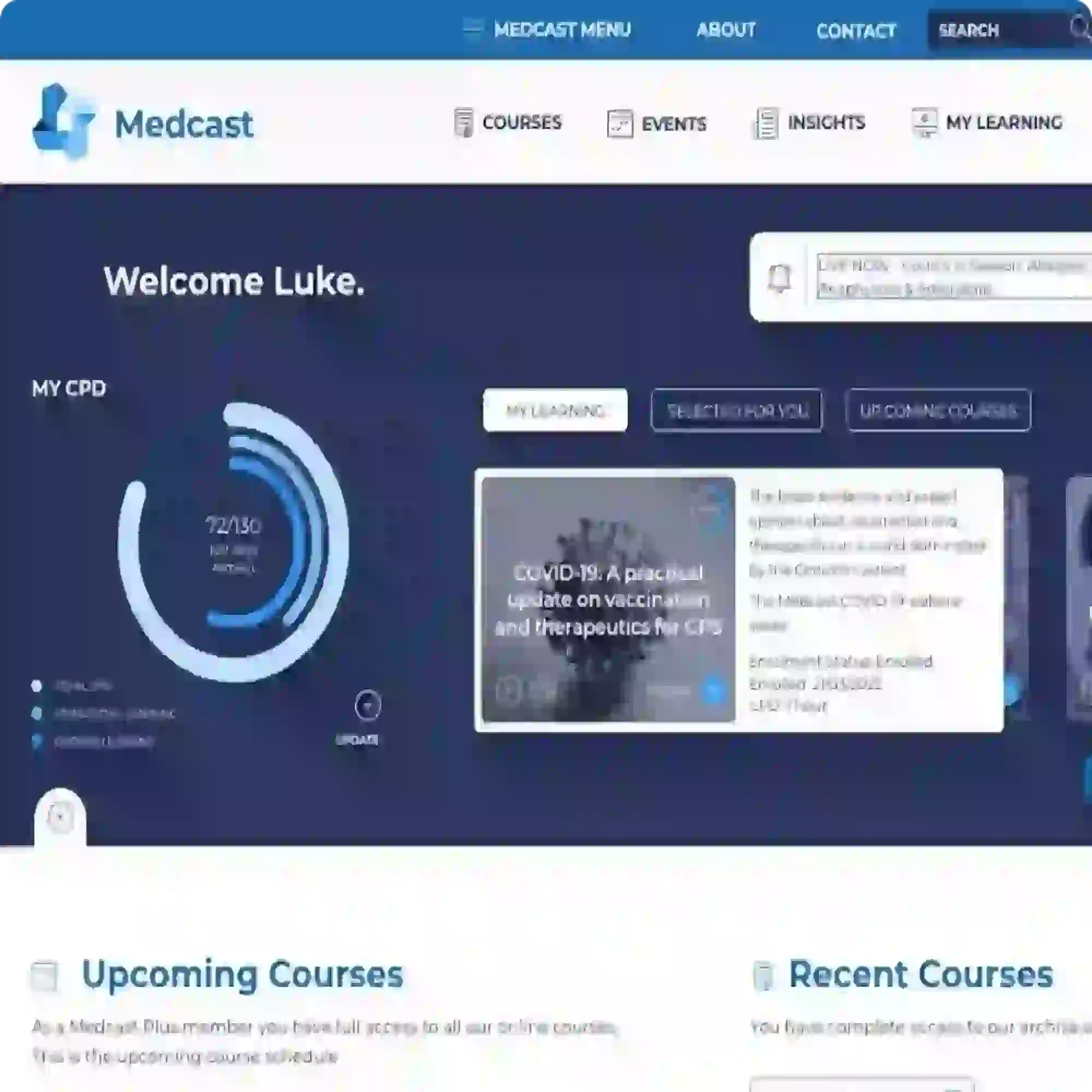Major depression - clinical fact sheet & MCQ
![]()
Overview
Depression is a common and disabling mood disorder characterised by persistent low mood, anhedonia, and associated cognitive, emotional, and physical symptoms.1,2 It exists along a continuum of severity and can be episodic or chronic. The condition significantly impairs daily functioning, increasing morbidity and mortality, including suicide risk.
Major (or clinical) depression is classified with the DSM-5 and ICD-11 (although the criteria differ slightly). It may be conceptualised as part of a broader mood disorder spectrum3 or into categories such as mild, moderate, and severe,2 or "less severe" or "more severe".1
Risk factors include female gender, genetic predisposition, stressful life events, chronic illness, substance use, and social isolation.1 Comorbidities such as anxiety disorders, personality disorders, and other illnesses such as diabetes and heart disease may often be present.1,3
Diagnosis of major depression
1. Clinical assessment:1
-
core symptoms include persistent low mood, anhedonia, and fatigue
-
associated symptoms include sleep disturbances, fatigue, appetite changes and significant weight gain/loss, impaired concentration, inappropriate guilt, feelings of worthlessness, psychomotor agitation or retardation, and suicidal ideation
-
symptoms are present for most of the day, nearly every day, for at least two weeks
-
assess effect on daily activities, relationships, and work
-
symptoms of insomnia, reported memory difficulties, and physical symptoms are more common in older adults2
2. Differential diagnoses:
-
depressive symptoms may be present in a range of other disorders without meeting the diagnostic criteria for major depression2
-
differential diagnoses may include:
-
bipolar disorder (consider if history of mania/hypomania)1,4
-
adjustment disorder (consider if triggered by psychosocial stressor occurring <3 months prior)5
-
substance-induced mood disorder (consider alcohol and drug use, including recent changes to medications)4
-
certain medical conditions (consider if recent onset or exacerbation of CNS, endocrine, inflammatory, or cardiovascular disease)4
-
seasonal affective disorder (consider if associated with seasonal changes and unrelated to other stressors)6
-
social isolation and loneliness, loss and grief, and cognitive impairment especially in older adults
3. Red flags:
-
suicidality3
-
psychotic depression3
-
severe cognitive impairment as may need closer monitoring
-
severe functional decline with neglect of self-care or inability to perform daily tasks3
-
catatonia3
Management of major depression
1. General principles:1,2
-
engage patients and family/caregivers (if appropriate) in treatment choices
-
tailor interventions based on severity a multimodal treatment strategy combining psychological, social, and lifestyle interventions, alongside pharmacological therapy when necessary, yields the best outcomes
-
consider coexisting physical and mental health comorbidities
-
address any barriers to care eg, cost and accessibility
2. Lifestyle and social interventions
-
Regular physical exercise (particularly outdoors and aerobic activity) is an effective treatment, either alone or as an adjunct to psychosocial interventions or pharmacotherapy1-3
-
Adherence to a Mediterranean-style diet (fruits, vegetables, grains and fish; minimal red meat) and avoiding excessive processed foods2,3
-
Social support in the form of peer groups, community activities, structured self-help, and formal social services1-3
-
Good sleep hygiene (such as a regular sleep-wake time and avoiding caffeinated drinks at least 8 hours before bedtime)2,3
3. Psychological interventions
Recommended for all severities, either alone (for less severe depression) or combined with medication (for more severe cases):1,2
-
cognitive behavioural therapy (CBT): first-line for mild to moderate depression; may be conducted individually or in a group
-
interpersonal therapy (IPT): focuses on the effect of interpersonal relationships on depression
-
behavioural activation: encourages re-engagement in positive activities; may be conducted individually or in a group
-
short-term psychodynamic psychotherapy: may be appropriate where emotional and developmental challenges in relationships underlie the depression
-
counselling: encourages emotional processing to develop coping mechanisms and find solutions
4. Pharmacological treatment for depression
In mild major depression, pharmacological intervention is not routinely recommended but may be offered if the patient expresses a strong preference, having been informed of the benefits and harms. In moderate major depression, antidepressants may be considered either as the initial intervention or as an adjunct to psychological therapies, depending on patient preference.1,2 The evidence to support antidepressant use for the management of depression in older adults is variable and modest at best, and must be carefully weighed against potential risks of harm.7 The harms include sleep disturbances, weight gain, sexual dysfunction, gastrointestinal issues and emotional numbness.2
Long-term harms associated with antidepressant use in older adults include an increased risk of falls and fractures, seizures, stroke and all-cause mortality.8
A comparison table of antidepressants, including common adverse effect considerations in older adults can be found here.
First-line options:2
-
selective serotonin reuptake inhibitors (SSRIs): fluoxetine, sertraline, escitalopram, citalopram, fluvoxamine, paroxetine
-
SSRIs are preferred due to tolerability versus efficacy
-
use paroxetine with caution as anticholinergic effects, sexual dysfunction; withdrawal and sedation is more common than with other SSRIs. Avoid use in pregnancy.9 However, for pregnant/breastfeeding patients already on paroxetine/fluoxetine, there is insufficient evidence of harm to warrant switching drugs.8
-
tetracyclic antidepressants: mirtazapine
-
common adverse effects include sedation and weight gain and increased risk of falls in older people
-
associated with weight gain
Second-line options:2
-
serotonin-norepinephrine reuptake inhibitors (SNRIs): venlafaxine, duloxetine, desvenlafaxine
-
agomelatine, vortioxetine
-
Review adherence and response at 2–4 weeks, adjusting treatment as needed:2
-
note that in older adults, onset of action may be delayed so it is important to allow an adequate trial (ie, up to 6 weeks)10
-
If treatment is effective, continue medication regimen for a minimum 6 months, up to 12 months then assess if deprescribing is appropriate2
-
60% of people with major depression respond to treatment with an initial antidepressant, but only 40% will achieve full resolution of symptoms2
-
If treatment response is partial or ineffective, investigate reasons (eg correct diagnosis, compliance, unaddressed comorbidities, drug-to-drug interactions), before increasing drug dosage or switching drugs:2
-
if a partial improvement is observed, consider titrating the dosage to the maximum until an acceptable response is achieved before switching drugs
-
Monitor for suicidality in the early weeks as higher risk of this in 7 to 10 days of commencing treatment, particularly with SSRIs and in younger patients2
-
Discuss psychological therapies, social and lifestyle interventions, ie exercise in combination with antidepressant prescribing2
5. Treatment-resistant major depression
For refractory major depression, refer to a psychiatrist for further treatment.2
6. Preventing recurrence of depression
-
CBT is most effective at reducing the risk of recurrence3, especially while tapering antidepressants - consider regular follow-up sessions after acute treatment for the first year2
-
If appropriate to cease antidepressants, commence tapering by reducing the current daily dose by 25% every week to month with monitoring every 1 to 2 weeks, adjusting the dose as required to help reduce withdrawal symptoms:11
-
slower tapering schedules may be needed depending on duration of antidepressant use, type of antidepressant, dosage and past experience of withdrawal symptoms – see clinical guide
-
Maintenance pharmacotherapy may be considered for recurrent depression:
-
start with the same antidepressant dose as was used for acute treatment2,3
-
review maintenance therapy after 1 year3
-
note there is no evidence for maintenance therapy beyond 3 years3 but it is accepted that some patients may benefit from lifelong treatment2
A comprehensive suite of clinical tools and resources for older adults can be found here, including a medicine comparison table and clinical guide for deprescribing antidepressants.
References
-
National Institute for Health and Care Excellence. Depression in adults: treatment and management. 2024. (last viewed February 2025).
-
Therapeutic Guidelines. Major depression. 2025. (last viewed February 2025).
-
Malhi G, Bell E, Bassett D. The 2020 Royal Australian and New Zealand College of Psychiatrists clinical practice guidelines for mood disorders. Australian & New Zealand Journal of Psychiatry. 2021; 55(1) 7–117. DOI: 10.1177/0004867420979353.
-
Therapeutic Guidelines. Disorders that can cause depressive symptoms. 2021. (last viewed February 2025).
-
Therapeutic Guidelines. Diagnosing adjustment disorder. 2021. (last viewed February 2025).
-
Therapeutic Guidelines. Seasonal affective disorder. 2021. (last viewed February 2025).
-
Hvidberg MF. Are antidepressants effective in the treatment of depression in the elderly? A critical umbrella review on reviews, methods, and future perspectives. Ment Health Sci. 2023 Jun 1;1(2):85–103.
-
Therapeutic Guidelines. Psychotropic use during pregnancy. 2025. (last viewed March 2025).
-
Taylor DM, Barnes TRE, Young AH. The Maudsley Prescribing Guidelines in Psychiatry. 14th ed. Hoboken (NJ): Wiley-Blackwell; 2021.
-
AMH Aged Care Companion (online). Adelaide: Australian Medicines Handbook Pty Ltd; 2024 Apr.
-
Horowitz M, Taylor D. The Maudsley deprescribing guidelines in psychiatry: antidepressants, benzodiazepines, gabapentinoids and z-drugs. Hoboken, NJ: Wiley-Blackwell; 2024.
Claim your CPD
After reading the clinical summary above and reviewing the references, complete the quiz to gain 30 minutes of EA CPD and 30 minutes of RP CPD.
You can either self-report CPD to your CPD home, or Medcast will track your learning via your personal CPD Tracker and you can download and report these points once a year. See our CPD Tracker FAQ.
Quiz
Please log in or sign up for a free Medcast account to access the case study questions and achieve the CPD credits.

The Quality Use of Medicines Alliance is a unique consortium of health sector organisations representing quality use of medicines expertise, education providers, researchers, colleges, peak bodies, member-based organisations, and consumer groups. Funded by the Australian Government under the Quality Use of Diagnostics, Therapeutics and Pathology (QUDTP) Program.
Co-billing and split billing are often a source of confusion for many GPs. This FastTrack clearly defines these two methods of billing, including examples, explanations of when it is and isn’t appropriate to co- or split bill, and common compliance pitfalls. 30 mins each RP and EA available with the quiz.
The Coordinated Veterans’ Care (CVC) Program is a DVA initiative that allows GPs to provide structured, proactive care in the community for eligible veterans and war widows. This FastTrack provides a guide to billing the CVC program, and outlines a strategy for its practice-wide integration.
Achilles tendinopathy is a common cause of posterior heel pain and functional impairment. GPs are well-placed to coordinate care for these patients. This FastTrack fact sheet provides a concise summary of diagnosis and non-surgical management, including when to refer. Earn 30mins each RP and EA CPD with the quiz.


